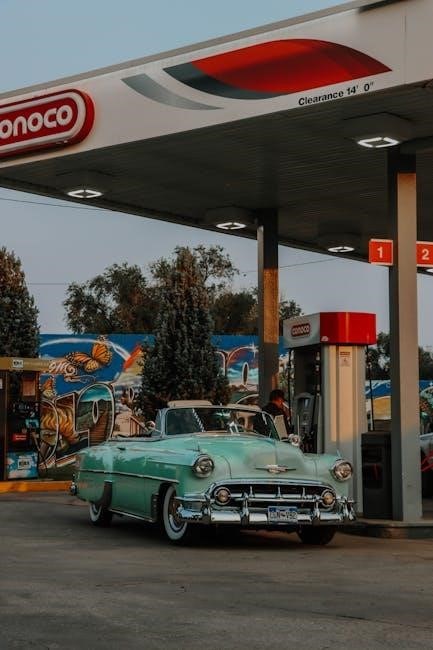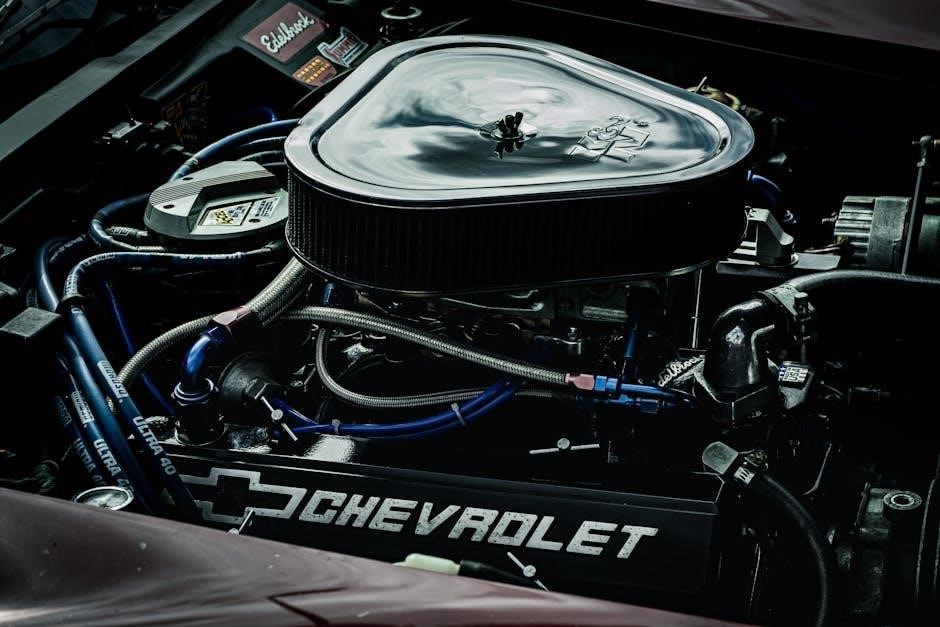chevy colorado ls swap guide
- by stephany

The Chevy Colorado LS swap represents a significant upgrade‚ transforming the truck’s performance. This guide provides a roadmap for enthusiasts looking to undertake this project‚ improving power and overall driving experience.
LS swapping a Chevy Colorado is a popular modification‚ breathing new life into these capable trucks. The process involves replacing the original engine with a more powerful LS-series engine from General Motors. This upgrade can dramatically enhance the Colorado’s performance‚ providing increased horsepower and torque. Enthusiasts often undertake this project to improve acceleration‚ towing capacity‚ and overall driving experience. Careful planning and execution are essential for a successful LS swap. This guide aims to provide a comprehensive overview of the process‚ covering everything from engine selection to wiring and exhaust modifications. By following these steps‚ you can transform your Chevy Colorado into a high-performance machine. Considering such a swap? You’re about to embark on a rewarding‚ albeit challenging‚ journey that will significantly boost your truck’s capabilities.
Planning and Preparation
Successful LS swaps require meticulous planning and preparation. This includes selecting the right engine‚ gathering essential parts‚ and understanding the necessary modifications. Thorough preparation minimizes complications and ensures a smoother swap process.
Selecting the Right LS Engine for Your Colorado
Choosing the correct LS engine is crucial for a successful Chevy Colorado swap. Several factors influence this decision‚ including budget‚ desired power levels‚ and intended use of the truck. Popular choices include the 5.3L LM7‚ known for its reliability and affordability‚ and the 6.0L LQ4/LQ9‚ offering increased power output.
Consider the engine’s condition and mileage‚ especially when sourcing from junkyards. Ensure compatibility with your desired transmission and factor in the cost of necessary modifications. Researching different LS engine variants and their specifications is essential for making an informed decision. Some tuners use trailblazer base files for auto swaps and CTSV for manuals.
Ultimately‚ the “best” LS engine depends on individual needs and priorities. A careful evaluation of these factors will lead to an optimal engine selection for your Colorado LS swap.
Essential Colorado Swap Parts
A successful Chevy Colorado LS swap requires a collection of essential parts designed for compatibility and performance. Motor mounts are crucial for securing the LS engine in the Colorado’s engine bay. Fuel system upgrades are often necessary to support the increased fuel demands of the LS engine.
Wiring harness adapters simplify the connection between the LS engine’s ECU and the Colorado’s electrical system. Exhaust headers are needed to efficiently expel exhaust gases from the engine. A compatible transmission is essential for transferring power to the wheels.
Cooling system upgrades‚ such as a larger radiator‚ help prevent overheating. Other necessary components include an aftermarket oil pan‚ swap headers‚ and potentially a new crossmember. Selecting high-quality parts ensures a reliable and well-performing LS-swapped Colorado.
Engine Mounting and Fitment
Achieving proper engine mounting and fitment is crucial for a successful Chevy Colorado LS swap. This involves using specialized swap mounts to correctly position the LS engine within the Colorado’s engine bay.
LS Swap Mounts for Colorado‚ Canyon‚ and H3
When performing an LS engine swap into a Chevrolet Colorado‚ GMC Canyon‚ or Hummer H3‚ factory mounts won’t work. To properly install an LS engine into these vehicles‚ specialized LS swap mounts are essential. These mounts are designed to ensure the engine sits correctly within the frame‚ providing the necessary clearance and alignment for other components.
These mounts are available for 2WD and 4WD models. They are often TIG welded with 1/4 inch thick steel and finished with a durable black powder coat. Many include proprietary thermal-resistant polyurethane bushings to withstand exhaust heat. Selecting the correct mounts is critical for a seamless engine swap.

Transmission Considerations
Selecting the right transmission is crucial for your LS-swapped Colorado. Compatibility with the chosen LS engine and intended use are vital. Options range from robust automatics to performance-oriented manuals‚ each with unique considerations.
Transmission Options and Compatibility
Choosing the correct transmission is paramount for a successful Chevy Colorado LS swap. Several options exist‚ each with its own strengths and weaknesses regarding compatibility‚ cost‚ and performance. Popular choices include the 4L60E and 4L80E automatic transmissions‚ known for their reliability and ease of integration. Manual transmission swaps are also possible‚ offering greater driver control but requiring more extensive modifications.
Consider the engine’s power output and intended use of the truck when selecting a transmission. A higher-horsepower engine will necessitate a stronger transmission to handle the increased torque. Ensure the chosen transmission is compatible with the LS engine’s bellhousing pattern and that the necessary adapters and modifications are accounted for. Researching specific transmission swap guides and consulting with experienced builders is highly recommended to ensure a seamless and reliable installation.

Wiring and Electronics
The Colorado LS swap’s wiring and electronics present a significant challenge; Adapting the LS engine’s wiring harness to the Colorado’s electrical system requires careful planning and execution to ensure proper functionality.
Harness Pinouts and ECU Tuning (E67)
Successfully integrating the LS engine into your Chevy Colorado requires meticulous attention to harness pinouts and ECU tuning‚ especially when dealing with the E67 ECM. Understanding the specific pinouts for connectors like the X125 14 and 16 pin connectors is crucial for proper wiring integration. For 2008-2012 Colorados‚ the E67 ECM and GEN 4 58x LS engines are common‚ necessitating careful tuning. Tuners often use trailblazer base files for automatic swaps and CTSV files for manual transmissions.
Furthermore‚ specific pinouts for the X125 14 and 16 pin connectors are essential for a seamless integration. Utilizing detailed repair manuals and seeking advice from experienced engine heads can provide valuable insights and prevent potential wiring issues. Addressing the electronics correctly will greatly increase performance.
Exhaust System
The exhaust system is a critical component of your LS-swapped Chevy Colorado. Careful header selection and potential modifications are necessary for optimal performance and proper fitment within the Colorado’s chassis.
Header Selection and Modification
Choosing the right headers for your LS-swapped Chevy Colorado is crucial for maximizing performance gains. Due to the unique chassis configuration of the Colorado‚ direct-fit headers are often unavailable. Universal LS swap headers or those designed for similar vehicles‚ like the Chevy C10‚ may require modification to ensure proper clearance and exhaust routing.
Consider factors like tube diameter‚ collector size‚ and material when selecting headers. Long tube headers generally offer better performance but may present fitment challenges. Shorty headers provide easier installation but may restrict exhaust flow. Ceramic coating can help reduce heat soak and improve exhaust scavenging. Be prepared to potentially modify the headers or exhaust system to achieve optimal fitment and performance in your Colorado LS swap. The Doug Thorley Tri-Y headers are a good starting point.
Cooling System
An adequate cooling system is critical for the longevity and performance of your LS-swapped Chevy Colorado. The factory Colorado radiator is typically insufficient for handling the increased heat generated by the LS engine‚ so an upgrade is necessary. Consider an aluminum radiator with increased core thickness and capacity for improved cooling efficiency. Electric fans are often preferred over the stock mechanical fan to provide better control and clearance.
Ensure proper coolant circulation by using the correct water pump for your LS engine and routing the coolant lines appropriately. You might need to adapt or modify the hoses to fit the Colorado chassis. A well-designed cooling system will prevent overheating and maintain optimal engine temperatures‚ contributing to the reliability and performance of your LS-swapped Colorado. Don’t forget to account for the added heat from potential turbo or nitrous setups.

Fuel System
Upgrading the fuel system is essential for an LS-swapped Chevy Colorado to ensure the engine receives adequate fuel delivery. The stock Colorado fuel pump is typically insufficient for the increased demands of an LS engine‚ especially if you plan on adding forced induction. Consider installing a higher-flowing fuel pump‚ either an in-tank or external unit‚ capable of supporting the horsepower goals of your build.
You may also need to upgrade the fuel lines and fuel injectors to handle the increased fuel flow. Ensure the fuel pressure regulator is properly sized and adjusted to maintain consistent fuel pressure. A return-style fuel system is recommended for boosted applications to prevent fuel starvation. Properly addressing the fuel system will ensure reliable performance and prevent lean conditions that can damage the engine.

Troubleshooting and Common Issues
LS swaps into Chevy Colorados‚ while rewarding‚ can present troubleshooting challenges. One common issue involves wiring harness integration. Mismatched pinouts or faulty connections can lead to starting problems‚ sensor malfunctions‚ or ECU errors. Thoroughly review wiring diagrams and double-check all connections to ensure proper communication between the LS engine and the Colorado’s electrical system.
Another frequent issue is related to cooling system efficiency. Overheating can occur if the radiator is undersized or airflow is restricted. Ensure proper radiator selection and consider adding an electric fan for increased cooling capacity. Exhaust leaks‚ fuel delivery problems‚ and transmission compatibility issues may also arise. Careful planning and attention to detail are crucial for a successful swap.
Cost Considerations
Undertaking an LS swap in a Chevy Colorado involves significant financial planning. Engine acquisition represents a major expense‚ with options ranging from junkyard finds to fully rebuilt units. Transmission costs‚ depending on the choice of manual or automatic‚ also contribute substantially. Essential swap parts‚ including engine mounts‚ wiring harnesses‚ and cooling system components‚ add to the overall budget.
Labor costs can vary widely‚ depending on whether you tackle the project yourself or hire a professional shop. Unexpected expenses often arise‚ such as modifications to the exhaust system or fuel lines. Budgeting for unforeseen issues is crucial. The total cost can easily range from $8‚000 to $10‚000 or more.
Related posts:
Thinking about an LS swap for your Chevy Colorado? This guide breaks down EVERYTHING. Ditch the headaches and get wrenching! Chevy Colorado LS swap info you need.
Posted in Guide